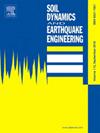A damping scaling factor model for vertical elastic response spectra from subduction earthquakes in offshore and onshore regions of Japan
IF 4.2
2区 工程技术
Q1 ENGINEERING, GEOLOGICAL
引用次数: 0
Abstract
This study aims to develop a damping scaling factor (DSF) model for scaling 5%-damped vertical elastic response spectra to other damping ratios for subduction earthquakes in both offshore (S-net) and onshore (K-NET and KiK-net) regions of Japan. To achieve this, more than 36,000 onshore records and 3400 offshore records from subduction earthquakes were used to develop the DSF model. The proposed DSF model is a function of moment magnitude, rupture distance, damping ratio, and station type, employing a linear function of ln(β) to differentiate between onshore, offshore buried, and offshore unburied ground motions. The coefficients of the DSF model were determined using Bayesian inference with Integrated Nested Laplace Approximation (INLA). The DSF model is applicable to subduction earthquake scenarios with moment magnitudes ranging from 5.5 to 9.1, rupture distances up to 1000 km, and damping ratios between 0.5 % and 30 %. The results show significant differences among onshore, offshore buried, and offshore unburied ground motions across most spectral periods at various damping ratios. An intersection point occurs near a spectral period of 1 s at the same damping ratios, where opposing variation trends are observed for magnitude and distance scaling before and after this point. Additionally, a standard deviation model for the proposed DSF model was developed using a cubic function of ln(β/5) for onshore, buried, and unburied ground motions. Compared to the observed standard deviation, the proposed model effectively captures the observed trends. The proposed DSF model can be effectively used to scale 5%-damped onshore and offshore GMMs to other GMMs with damping ratios ranging from 0.5 % to 30 % for subduction earthquakes. This is important for implementing probabilistic seismic hazard assessments, seismic design, and seismic zoning in both offshore and onshore regions of Japan.
求助全文
约1分钟内获得全文
求助全文
来源期刊

Soil Dynamics and Earthquake Engineering
工程技术-地球科学综合
CiteScore
7.50
自引率
15.00%
发文量
446
审稿时长
8 months
期刊介绍:
The journal aims to encourage and enhance the role of mechanics and other disciplines as they relate to earthquake engineering by providing opportunities for the publication of the work of applied mathematicians, engineers and other applied scientists involved in solving problems closely related to the field of earthquake engineering and geotechnical earthquake engineering.
Emphasis is placed on new concepts and techniques, but case histories will also be published if they enhance the presentation and understanding of new technical concepts.
 求助内容:
求助内容: 应助结果提醒方式:
应助结果提醒方式:


